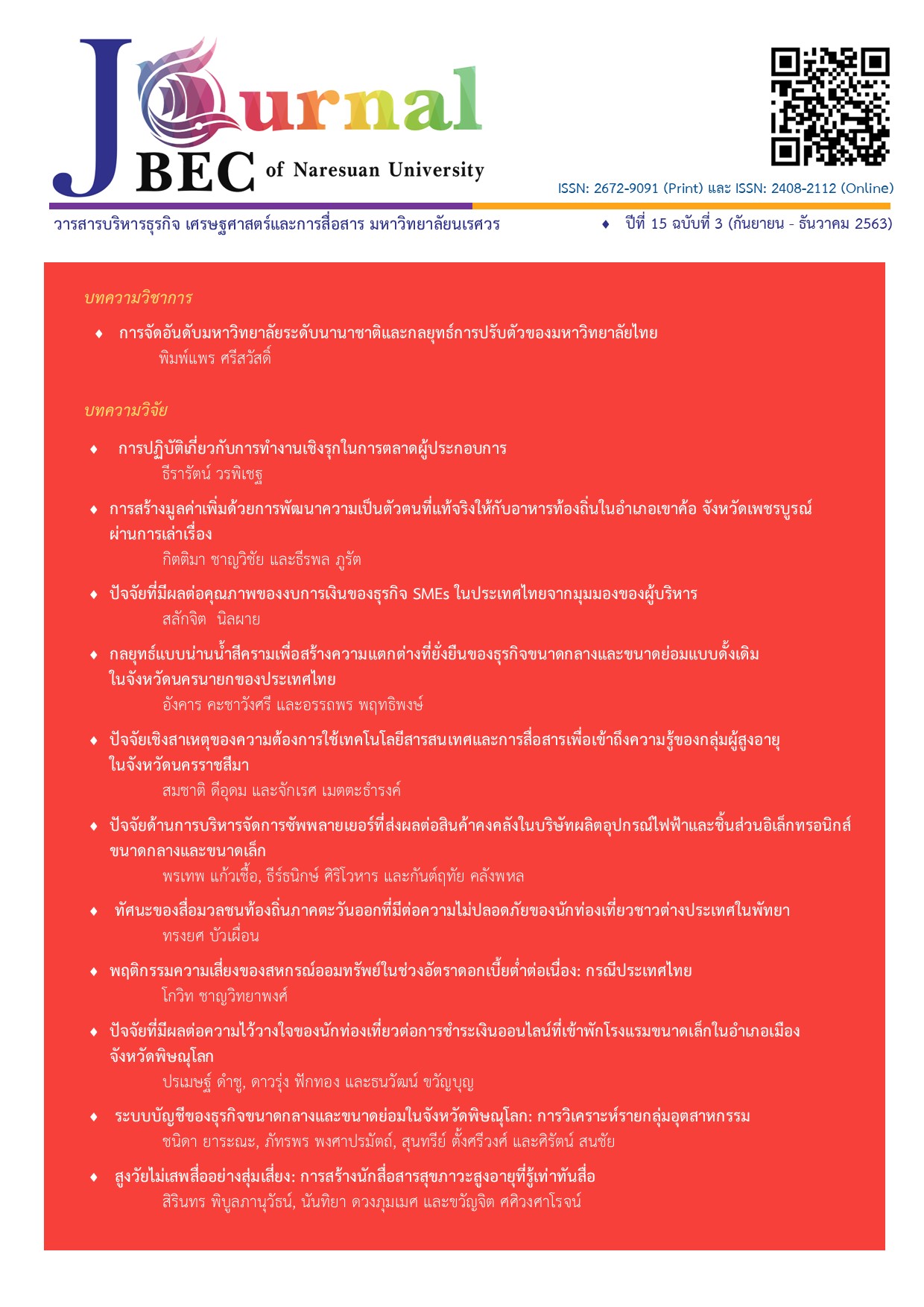การจัดอันดับมหาวิทยาลัยระดับนานาชาติและกลยุทธ์การปรับตัวของมหาวิทยาลัยไทย
Main Article Content
บทคัดย่อ
ในแต่ละปีได้มีการจัดอันดับมหาวิทยาลัยโลกออกมาจากหลายสถาบัน ซึ่งมหาวิทยาลัยที่ได้รับการจัดอันดับจะได้รับการยอมรับเกี่ยวกับชื่อเสียงและคุณภาพของมหาวิทยาลัยดังนั้นหลายมหาวิทยาลัยจึงมีความพยายามวางกลยุทธ์และกำหนดนโยบายให้มหาวิทยาลัยของตนได้มีอันดับโลกที่ดีขึ้นบทความนี้มีวัตถุประสงค์เพื่อให้ความรู้ความเข้าใจเกี่ยวกับการจัดอันดับของมหาวิทยาลัยจากสามสถาบันการจัดอันดับที่ได้รับการยอมรับในระดับสากล ได้แก่ Academic Ranking of World University, Times Higher Education และ Quacquarelli Symonds ซึ่งพบว่าหลักการสำคัญที่ใช้ในการพิจารณาอันดับมหาวิทยาลัยโลกของทั้งสาม คือมุ่งเน้นงานวิจัยเป็นหลักมากกว่าคุณภาพการสอน นอกจากนี้ในบทความยังได้วิเคราะห์ภาพรวมการแข่งขันของมหาวิทยาลัยไทยรวมถึงได้เสนอแนะแนวทางในการปรับตัวเชิงกลยุทธ์ของมหาวิทยาลัยไทย 3 ด้านด้วยกัน คือ ด้านการจัดการของมหาวิทยาลัย ด้านคุณภาพบุคลากร และด้านความเป็นนานาชาติและสิ่งอำนวยความสะดวก เพื่อเพิ่มโอกาสและศักยภาพในการแข่งขันในระดับสากลได้อย่างเต็มความสามารถและเป็นไปได้จริงในอนาคต ทั้งนี้เพื่อผลลัพธ์คือคุณภาพการศึกษาที่มีประสิทธิภาพต่อผู้มีส่วนได้เสียในทุกระดับ และเพื่อความยั่งยืนของมหาวิทยาลัยโดยรวม
Article Details
เอกสารอ้างอิง
Academic Ranking of the World University (ARWU). (2019). Ranking of the world university 2019. Retrieved December 19, 2019, from http://www.shanghairanking.com/
Academic Ranking of the World University (ARWU). (2020). Academic ranking of world universities 2020. Retrieved August 25, 2020, from http://www.shanghairanking.com/ARWU2020.html
Chiangmai University. (2016). University announcement (no. 29/2559): international publication intensive. Retrieved January 28, 2020, from http://www.ba.cmu.ac.th/wp-content/uploads/2018/04/5.1.pdf
Collins, F. and Park, G. (2016). Ranking and the multiplication of reputation: reflections from the frontier of globalization higher education. Higher Education, 72, 115-129.
Elsevier. (2020). Ranking organization. Retrieved March 20, 2020, from https://www.elsevier.com/solutions/scopus/who-uses-scopus/ranking-organizations
Hazelkorn, E. (2014). Rankings and the global reputation race. New Directions for Higher Education. No.168.
Hazelkorn, E. (2017). Ranking and higher education: reframing relationships within and between states. the Centre for Global Higher Education. UCL Institute of Education.
Hazelkorn, E. (2018). Reshaping the world order of higher education: the role and impact of rankings on national and global systems. Policy Reviews in Higher Education, 2(1), 4-31.
Hazelkorn, E. (2019). The dubious practice of university rankings. Retreived March 21, 2020, from https://elephantinthelab.org/the-accuracy-of-university-rankings-in-a-international-perspective/
Hou, Y. and Jacob, W.J. (2017). What contributes more to the ranking of higher education institutions? A comparison of three world university rankings. The international Education Journal: Comparative Perspectives, 16(4), 29-46.
Johnes, J. (2018). University rankings: what do they really show?. Scientometrics, 115, 585-606.
Kehm, B. M. and Erkkila, T. (2014). Editorial: The ranking game. European Journal of Education, 49(1), 3-11.
Mae Fah Luang University. (2019). Mae Fah Luang University was ranked 1st in Thailand and was grouped in 601-800 band of the best university from THE World University Rankings 2020. Retrieved March 25, 2020, from https://www.mfu.ac.th/news/news-detail/detail/News/5021.html
Pavel, A. (2015). Global university ranking-a comparative analysis. Procedia Economics and Finance, 26, 54-63.
Piro, F.N. and Silvertsen, G. (2016). How can differences in international university rankings be explained?. Scienometrics, 109, 2263-2278.
QS Intelligence Unit (2015). How do students use rankings? the role of university rankings in international choice. London. UK: QS Intelligence Unit
QS Quacquarelli Symonds. (2020). Who Uses University Rankings and are They Important?. Rreieved March 25, 2020, from https://www.qs.com/who-uses-rankings-and-how-do-they-affect-decisions/
Rakrungtham, K. (13 March 2018). ‘Thai universities’ with challenge on dramatically change. The Momentum. Retrieved August 25, 2019, from https://themomentum.co/thailand-and-university-ranking/
Rauhvargers, A. (2013). Global university ranking and their impact-reportII. Brussel: European University Association.
Robinson-Garcia, N. and Jimenez-Contreras, E. (2017) Analyzing the disciplinary focus of universities: Can rankings be a one-size-fits-all? In: Downing, K., F.A. Ganotice (eds). World University Rankings and the Future of Higher Education. IGI Global, 161-185.
Safon, V. (2013). What do global university rankings really measures? the search for the x factor and the x entity. Sciencetometrics, 97, 223-244.
Thammasat University. (2018). Grants for journal’s publication. Retrieved August 25, 2019, from https://tu.ac.th/ypin- factsheet03
Times Higher Education (THE). (2019). Graduate employability: top universities in the United States ranked by employers 2019. Retrieved March 20, 2020, from https://www.timeshighereducation.com/student/best-universities/graduate-employability-top-universities-united-states-ranked-employers#survey-answer
Times Higher Education (THE). (2020). World university ranking. Retrieved March 20, 2020, from https://www.timeshighereducation.com/world-university-rankings
University of Cambridge. (2020). Nobel prize. Retrieved August 25, 2019, from https://www.cam.ac.uk/research/research-at- cambridge/nobel-prize
Yonpeum, C. (22 April 2018). Mahidol to the world class universities raises new determination statement: Wisdom of the land. Post Today. Retrieved August 28, 2019, from https://www.posttoday.com/politic/report/548801


